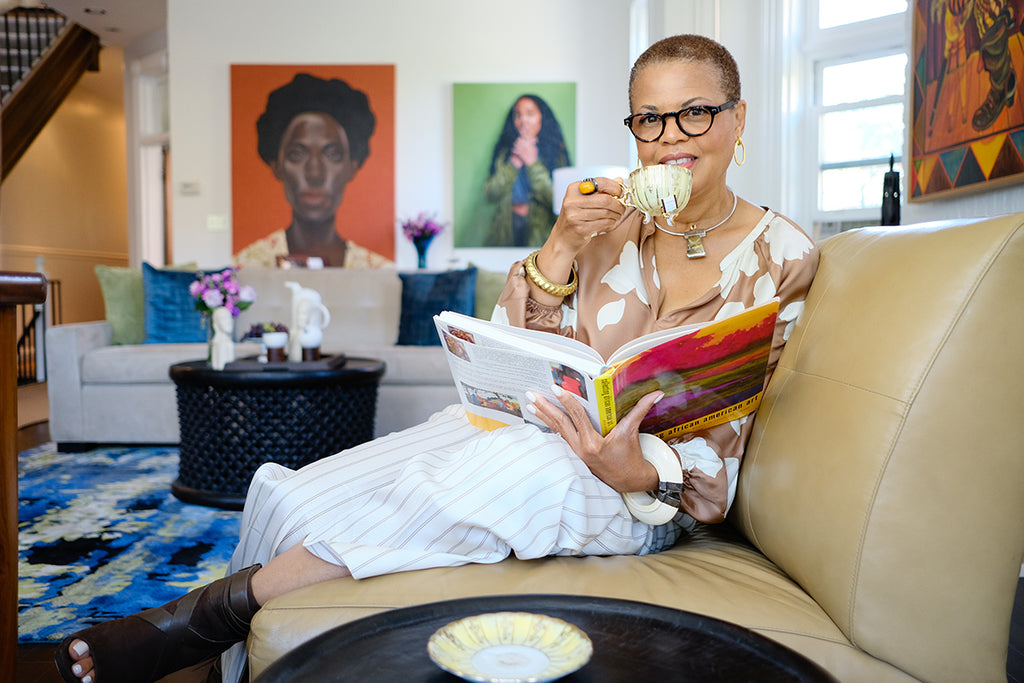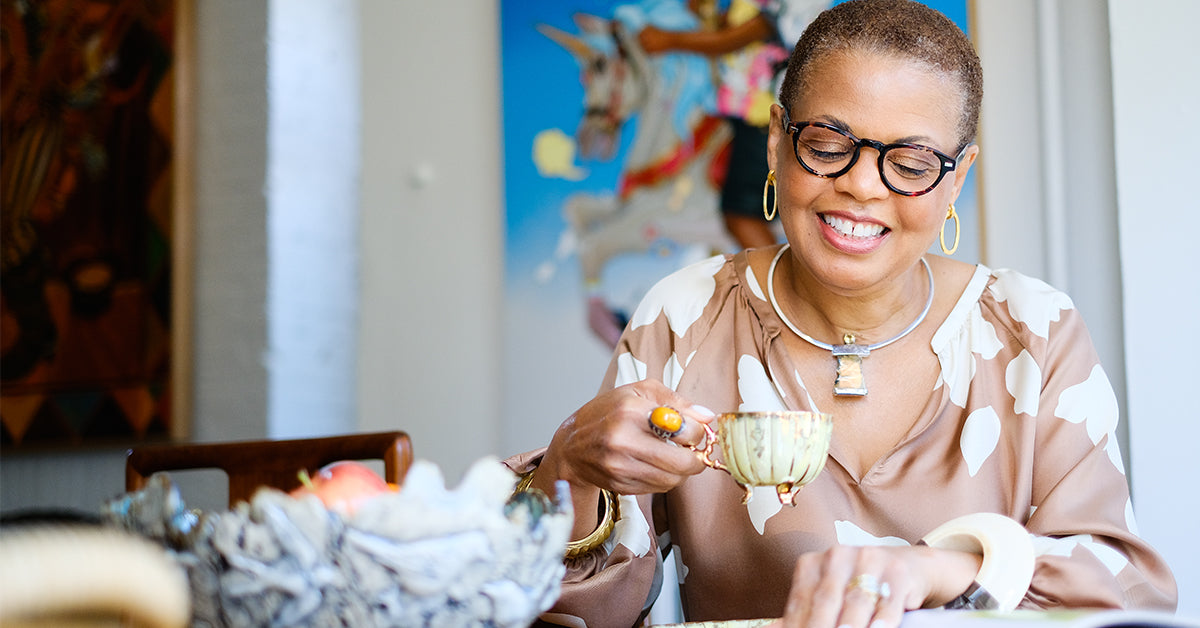
Myrtis Bedolla
Curator, Art Advisor & Founder, Galerie Myrtis
Growing up in Chicago, Myrtis Bedolla, our November Teafluencer, gained an appreciation for tea from her grandmother and mother. As an adult and owner of the groundbreaking art gallery Galerie Myrtis, she incorporates tea into her Tea with Myrtis salons to help viewers relax and engage in a world that some find intimidating. Meanwhile, she is helping black artists find a welcome home for their art while helping the art world change its attitudes about who is welcome in the art world and who is not. Read about Myrtis, her impressive work and her love of tea.
Harney: Tell us a little about you. Where are you from, educational background, where you live, family, etc.
Myrtis: I was born in Aurora, Illinois, which is a suburb of Chicago. My family moved to Chicago when I was around two years old, so I consider myself a Chi-town girl. I am the oldest of three girls. I graduated from Jones Commercial High, a college preparatory school in the city. The educational experience there and working with my grandfather in his cleaning business inspired me to become an entrepreneur.
I am the recipient of the Foreign Language and Area Studies (FLAS) Fellowship, African Language Institute, Shona Language, and Culture from Michigan State University. I hold a Bachelor of Science degree in Business Administration from the University of Maryland, University College, and received my curatorial training at the Maryland Institute College of Art in Baltimore, Maryland, and earned online certificates in Cultural Theory for Curators and Curatorial Procedures from the Node Center for Curatorial Studies, Berlin, Germany.

Myrtis Bedolla in Galerie Myrtis
Photographs: Shanequa Gay (background)
Image credit: Ryan Stevenson, Photographer
Harney: When did your interest in art begin?
Myrtis: I grew up in a home with original works of art. My father was an art collector and my mom loved to draw. Their aesthetic was very eclectic and gave birth to my appreciation for art. One of the most treasured pieces in my collection is a painting my mother gifted to me. During my childhood, it hung in the living room in my parent’s home. It is now proudly displayed in mine.
Harney: What did you do before you opened Galerie Myrtis?
Myrtis: Before opening Galerie Myrtis, I worked in the subscription department in an association that publishes medical journals. My responsibility was to assist with developing campaigns to market and promote the publications. It was my background in business and marketing that led to my involvement with artists. I first began assisting them with developing professional portfolios. After successfully securing a solo exhibit for an artist, word spread that I was an artist’s representative, and my first business venture, Creative Artisans (88), was born.
Harney: What drove you to open your own gallery? Why was that important to you?
Myrtis: It was at the encouragement of a friend that I launched the gallery in 2006. He invited me to open in a building he owned on Capitol Hill in Washington, DC. Over the years, he had been very supportive. He witnessed the growth of Creative Artisans and my evolution from an artist’s representative to a consultant who advised collectors in building their art collections. In 2008, I moved the gallery to its current location in Baltimore, Maryland.
I knew stepping into the role of a gallery owner was going to be demanding. But, establishing the gallery was essential to me because it would allow me the freedom to operate as I choose. I would no longer have to rely on other gallerists for opportunities to exhibit the artist’s work, nor deal with censorship when seeking to feature a work of art or address a subject that might be deemed controversial.
Harney: On your gallery’s website, Galerie Myrtis is described as specializing in 20th and 21st century American art with a focus on work created by African American artists. It also says, “The gallery opened its door to utilize the visual arts to raise awareness for artists who deserve recognition for their contributions in artistically portraying our cultural, social, historical, and political landscapes; and to recognize art movements that paved the way for freedom of artistic expression.” How did you choose these traits to shape your choices of artists to feature in your gallery, and as traits that would define Galerie Myrtis?

Caption: Myrtis Bedolla, Founding Director, Galerie Myrtis
Image credit: Ryan Stevenson, Photographer
Myrtis: In my formal studies of American art, African American artists' work and their portrayal of the American experience were treated with a sense of “otherness” outside of the canon and as an inferior derivative of European art.
The imagery resonated with me, reflecting who I am and the rich history and culture I am a part of. In the artwork, I discovered narratives that speak to black people's cultural, social, historical, and political concerns. Art produced by black artists became my primary focus as I gained a greater understanding of its relevance and essential role in society.
Harney: You were one of several black gallery owners featured in a New York Times article entitled “Black Gallerists Press Forward Despite a Market That Holds Them Back.” What are the challenges you face in a profession that is primarily dominated by white males, and how do you see your industry changing?
Myrtis: The challenge I face is battling against systemic racism that exists in the arts. It is an industry deeply rooted in white privilege and a history of discriminatory practices. There is evidence of inequities in funding the acquisition of work by black artists and negligence in including their work in exhibitions at the institutional level. In turning to the commercial sector, black-owned galleries are denied acceptance into significant art fairs, critical to gaining international exposure for the artists. For gallerists, it provides the opportunity to connect with museum curators and major collectors.
Also key to gaining credibility in the industry is a review written by an art critic or article in a scholarly journal or magazine —artists represented by black-owned galleries are rarely the focus.
As I witness museums' policy changes to right the historical wrong of their past exclusionary practices and seek to build collections that embrace the American experience as told through an African American lens, I remain hopeful. As I observe the shift toward equity and inclusion in the industry, and African American artists gain greater recognition for their contribution to the canon, I am optimistic about the future of black art and my role as a gallerist.
Harney: In addition to being a gallery owner you are, among other things, a writer, consultant and as a member of several boards and professional organizations, an advisor and influencer. But one specific project you have been involved in stands out: tell us about The World of Women of Niger and what that project meant to you.

Caption: Haoua, Master Potter of the village of Saga. Firing pots which were gifted to the team.
Image credit: Christopher Bedolla
Myrtis: Art has enriched my life in ways I could never have imagined. As a result of my involvement, I have traveled to several countries in Europe and Africa. One of the highlights of my career was an opportunity to participate in a project in 2003 with Operation Crossroads Africa and the National Museum of Niger in Niamey to research and document the utilitarian and ceremonial art forms created by women of the eight ethnic groups (Hausa, Djorma, Fulani, Tuareg, Gurmance, Kanuri, Arab, and Tubu) in Niger. Jackie Kakembo led the project, which was the first for the organization centered around traditions preserved by women artisans. My son, Christopher, and I were among the team of seven. Our fieldwork consisted of trips to villages throughout the country to observe master potters create bowls and vessels out of clay, the beading of ceremonial necklaces, and the sewing of utilitarian sacks (bags).

Caption: A day in the field with team members Igaa Bedell and Abigail Jefferson (daughter and mother respectively) with Fulani Women.
Image credit: Christopher Bedolla

Caption: Myrtis (left) adorned with henna as the team prepares for the Taureg welcoming ceremony.
Image Credit: Christopher Bedolla
The experience was life-altering on so many levels. Having contributed in any way to preserving the traditions and legacy of the women I encountered is humbling. And sharing the experience with my son, Christopher, has created a special bond between us. We slept in the desert and ate camel together. What more could a mother want?

Caption: Villager of Saga (left) with Christopher Bedolla, Son (right)
Image credit: Myrtis Bedolla
Harney: What do you find most gratifying about what you do? What do you still want to accomplish?
Myrtis: Placing the work in museum collections is very gratifying to me. Their role in our society is to preserve our culture and use art as an education tool—to bring greater understanding to who we are individually and collectively. When the art created by a black artist becomes part of a museum’s permanent holdings, it allows the institutions to serve the public more richly and effectively.
I have many goals I am seeking to accomplish. Among them is the mission to become a blue-chip gallery and gain international exposure for the artists and gallery.

Myrtis Bedolla in Galerie Myrtis
Artwork: Lavett Ballard (left) and Delita Martin (background)
Image credit: Ryan Stevenson, Photographer
Harney: We LOVE Tea with Myrtis: Artistically Speaking, of course! Tell us how that began, about the artists you talk to and why you incorporated tea into your interviews.
Myrtis: Originally, Tea with Myrtis began in 2012 as a series of art salons in which artists, arts professionals and legal experts addressed current trends in the art world. I incorporated tea because it lends itself perfectly to the communal and relaxed environment I sought to create. For some, visiting a gallery can be a very intimidating experience. The salons are unpretentious, educational and fun.
Tea with Myrtis: Artistically Speaking was created in response to the pandemic. The inability to host the salon series in the gallery forced me to rethink my approach and turn to technology to engage the artists and the public. With each exhibition, programming plays a critical role in the experience. I believe it is essential that the artist’s intention is understood; this is why I engaged them in conversation.
Harney: What role does tea play in your personal life? Do you have any rituals?
Myrtis: Tea has always been integral to my life. During summers spent with my grandparents, my grandmother served tea with breakfast. I loved her beautiful teapots, which have inspired my collection. Years ago, my aunt taught me to make sun tea. I still use her recipe, 12 tea bags per gallon. It has never failed me. There is nothing more refreshing on a hot summer day. During Chicago winters, my mom made hot tea for my sisters and me with honey and lemon to warm our insides and ward off colds.
I have three tea rituals:
- Having a cup of tea every Sunday morning with my husband.
- Serving tea during family gatherings.
- Sending a gift box of Harney and Sons teas to clients to express my appreciation for their support. I believe in expressing gratitude.
Harney: Do you have any favorite flavors or types of Harney & Sons tea (or anything on your list to try?)
Myrtis: Picking a favorite tea is like picking a favorite child; I can’t do it. I love them all! Each tea possesses a unique taste that I enjoy and savor.
You can check out episodes of “Tea with Myrtis: Artistically Speaking” as well as examples of the art in Galerie Myrtis on her website, plus see what else is going on in Myrtis’ very busy world on her Instagram and Facebook pages. Like Myrtis, we believe in expressing gratitude and can think of no better way to do that than through the gift of tea, along with kind words and actions. So thank you, Myrtis, for sharing your world with us. All photography was provided by Myrtis.
















5 comments
Kathy
I would love to have tea with Myrtis! What a wonderful article about a wonderful women! Kudos to her for the great work she is doing! She is such an inspiration!
I would love to have tea with Myrtis! What a wonderful article about a wonderful women! Kudos to her for the great work she is doing! She is such an inspiration!
Deanah Greene
This article was so inspiring. I immediately went to her gallery site. I am a black woman and love the fact that you showcased a a black female entrepreneur and black art.❤️ I must now go save my pennies.😀
This article was so inspiring. I immediately went to her gallery site. I am a black woman and love the fact that you showcased a a black female entrepreneur and black art.❤️ I must now go save my pennies.😀
W.E. Lempart
Intergrating tea and art as a philosophy in life has been achieved by Myrtis Bedolla. This interview reminds me of Okakura Kakuzo essay on art appreciation in his book “The Book of Tea”. Enjoyed reading the Teafluencer with a cup of Sencha.
Intergrating tea and art as a philosophy in life has been achieved by Myrtis Bedolla. This interview reminds me of Okakura Kakuzo essay on art appreciation in his book “The Book of Tea”. Enjoyed reading the Teafluencer with a cup of Sencha.
Kirsten Corbett
Art and tea do seem to go hand-in-hand. I’m in love with Myrtis’ teacup and saucer! Any chance you can tell us what it is?
Art and tea do seem to go hand-in-hand. I’m in love with Myrtis’ teacup and saucer! Any chance you can tell us what it is?
Adrianne Baer
I always read the emailed Teafluencer articles but never click to read more online until today. Myrtis was fascinating to read about, thank you for introducing me to her!
I always read the emailed Teafluencer articles but never click to read more online until today. Myrtis was fascinating to read about, thank you for introducing me to her!